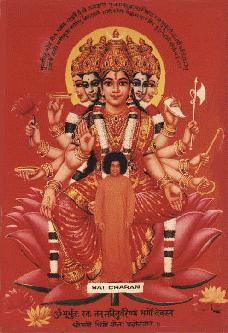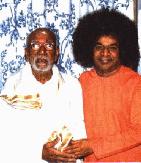
A VEDIC SCHOLAR IS INSPIRED
The Revelation of Sathya Sai Gayathri

By G.V. Subba Rao, reprinted from Sanathana Sarathi, March 1979




The occasion was Christmas Eve of 24 December 1977. The place was the Sathya Sai Mandir in Brindavan, Whitefield, near Bangalore. The assembled audience consisted of a group of students and faculty members of Sri Sathya Sai College as well as a number of visiting devotees. It was in the glorious presence of Sri Sathya Sai Baba himself that a great vedic scholar Pandit Sri Ghandikota Subrahmanya Shastry was inspired to announce Sri Sathya Sai Gayathri, the mystic formula devoted to Sri Sathya Sai.
This reads as follows:
The meaning of this is:
This Sathya Sai Gayathri, like other Gayathris, is on par with Veda Mantra or mystic formula. It has 24 letters; it consists of three lines, each with eight letters. Such a composition has unique properties. According to Maharishi Vararuchi, the numerology of all letters adds up to 108. That is why recitation is to be done 108 times; to realize the full effect of Siddhi - which is signified by the 108th number, i.e. Meru or the tassel of a rosary or Japamala. Ashtottara Sata Nama - the 108 name-chanting leads to the realization of God, which is the goal.
Every Gayathri Mantra has a revealing prophet or Rishi and a presiding deity, Adhishthana Devata, who is the subject of the mantra. This mantra is expressed through the inner workings of Sathya Sai through the mouth of Pandit Sri Ghandikota Subrahmanya Shastry in the presence of Sri Sathya Sai Baba. Needless to say that Sai Baba himself is the presiding deity of this mystic formula or Mantra.
Shri Subrahmanya Sastry expressed the essence of the Sathya Sai Gayathri in a verse of metrical form, Anushtup Chandas:
This verse means:
That same morning Sri Sathya Sai graced the author and his family with very valuable teachings which are summarized in translation from Telugu:
The real purpose of performing Karma is only to get rid of Ahamkara or Mineness; Karma or Work, offered for the love of God comes back as Grace. This is the strategy of escaping the bondage of Samsara. One must persuade the heart to meditate; persuade the heart and you persuade the people. If you do wrong, your heart feels it. The heart is a witness. Move from the gross to the subtle, from the sense, the mind and the intellect, getting closer to the Atman.
The effulgence of Atman transcends the senses, whose nature is fickleness. The senses do not have the capacity or power of decisiveness. Karma and Upasana are the two wings which enable us to fly upward to God. Karma is for disciplining the body, mind, and intellect; Karma is not slavery to senses or fate. Life is a long journey which is helped by Yantra, Tantra and Mantra; these make the journey easier. We must reduce our luggage. Being detached in Samsara is like mascara in the eye, like Ghee on the tongue; one need not leave the worldly activity. The journey should be continued till the end. Don't get off the train in wayside stations. One should pursue one's Svadharma, one's own calling, till the end of the journey. One should reach the real destination with enthusiasm and animation, with a pure heart. Your pole-star or light is the name of God; that supreme light is the light of life, Jivanjyothi.
The performance of duty by the God-given body is essential. Man's accumulated blemish or sin is washed away by such action. Karmakanda, the field of action, is like the flower from which follows the Upasana Kanda, the field of spiritual practice, which is like the raw fruit. This subsequently ripens into a sweet fruit of Jnana, Knowledge.
The One Supreme is described in different ways by the wise: Ekam Sat Viprah Bahudah Vadanti. The Puranas and the Vedas contain the knowledge about nature, Prakruta Jnanam. They teach the path of subtle action. They teach that immortality is the fruit of sacrifice. The path of enjoyment, Bhoga, leads only to illness and suffering, Roga. It is often said one cannot cross the path of Karma on a dusty road. It is only when you stop the moving vehicle that one is overtaken by the trailing dust. So long as you keep moving or performing Karma in a detached way, you are not overtaken by its bondage. Narada, who is omniscient, did not leave the field of action or Karmakanda.
There are really two aspects of conduct, good conduct and bad conduct; with egoism it becomes bad conduct. Ahamkara, mineness or selfishness, is the crown of all bad qualities. Wearing such a crown, even such notable personalities as Kamsa, Sisupala, Dantavakra, Vishwamitra, and Sathyabhama came to grief.
All the lights of life are lit up on Divali day; so, light up the darkness of the past, which enveloped the Light of the Real Self in the past. The technique is to remove the threads of attachment one by one; at the end, the 'cloth' disappears and the mind is clear and pure.
The mind is a bundle of desires. It is necessary to live in seclusion in order to avoid the wrong paths, thereby avoiding the five wrongs or blemishes of sight, mind, action, and intellect. Moksha or liberation is nothing but Mohakshaya, the depletion of infatuation of the mind. One should engage in spiritual
practices, Sadhana, to the extent feasible. Strength and support are gained thereby for the performance of one's own duties and actions. Imitation and invidious comparisons with others are harmful and weakening.
Daily life is Tapas. Tapas is devotion to the living gods - father and mother. Sadhana is the cultivation of special attention to one's true self. Sankaracharya expresses it in a paradoxical manner:

|
|
Sri Subrahmanya Sastry with Bhagavan Baba |